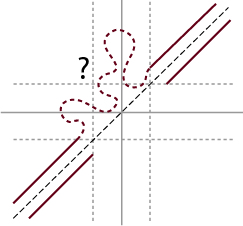First, let’s clarify that this post has nothing to do with the Kakeya conjecture (except for the word ‘needle’ in it). Anyways, I was asked the following question via an e-mail from Charles this summer: (It turns out that the question was invented by Jonathan King and then communicated to Morris Hirsch and that’s where Charles heard about it from) In any case, I find the problem quite cute:
Problem: Given a smoothly embedded copy of in
containing
. Is it always possible to continuously slide a unit length needle lying on the ray
to the ray
, while keeping the head and tail of the needle on the curve throughout the process?
i.e. the curve is straight once it passes the point and
, but can be bad between the two points:
We are interested in sliding the needle from the neigative -axis to the positive
-axis:
Exercise: Try a few examples! It’s quite amusing to see that sometimes both ends of the needle needs to go back and forth along the curve many times, yet it always seem to get through.
One should note that this is not possible if we just require the curve to be eventually straight and goes to infinity at both ends. As we can see on a simple ‘hair clip’ curve:
The curve consists of two parallel rays of distance apart, connected with a semicircle. A unit needle can never get from one ray to the other since the needle would have to rotate
degrees and hence it has to be vertical at some point in the process, but no two points on the curve has vertical distance
.
After some thought, I think I can show for each given curve, 'generic' needle length can pass through:
Claim: For any embedding as above, there is a full measure and dense
set
of lengths where the needle of any length
can slide through the curve.
Proof: Let be a smooth parametrization of the curve s.t.
for
.
Define where
.
Hence vanishes on the diagonal and takes positive value everywhere else.
Since for
, hence
for
.
contains four rays
:
Observation: a needle of length can slide through the curve iff there is a continuous path in the level set
connecting the two rays above the diagonal. (This is merely projection onto the
and $larex y$-axis.)
We also have is
other than on the diagonal. (It behaves like the absolute value function near the diagonal). By Sard’s theorem, since
is
on
, the set of critical values is both measure
and first category.
Let be the set of regular values of
. For any
, by implicit function theorem, the level set
is a
sub-manifold.
Since the arc is compact, we can find large
where
.
Hence for and
, we have
The same holds with and
i.e. takes value
in the shaded region below:
Hence for ,
is a
dimensional sub-manifold, outside a bounded region it contains only two rays. We also know that the level set is bounded away from the diagonal since
vanishes on the diagonal. By an non-ending arc argument, one connected component of
must be a curve connecting the end points of the two rays. Establishes the claim.
Remarks: This problem happens to come up at the very end (questio/answer part) of Charles’s talk in the midwest dynamics conference last month (where he talked about our joint work about funnel sections). A couple weeks later Michal Misiurewicz e-mailed us a counter-example when the curve is not smooth (only continuous).
Initially I tried to use the above argument to get the length needle. Everything works fine until a point where one has a continuum in the level set connecting the end-points of the two rays. We want the continuum to be path connected. I got stuck on that. In the continuous curve case, Michal’s counter-example corresponds to the continuum containing a
curve, hence is not path connected.
I believe such thing cannot happen for smooth. The hope would be that the length needle can slide through any
(or
) curve. (Note that once the length
needle can pass through, then all length can pass through just by rescaling the curve.) In any case, still trying…





